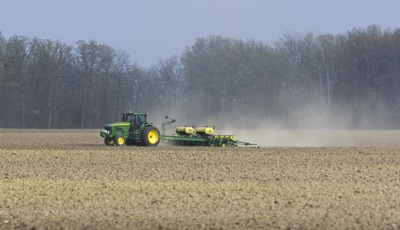Saturday, April 14th, 2012
Area farmers planting corn
By Nancy Allen

Photo by Mark Pummell/The Daily Standard
A farmer plants a field south of Rockford on Tuesday evening. Ag officials in Mercer and Auglaize counties expect most farmers will get into their fields after the anticipated rain today.
Between 5 and 10 percent of the corn in Mercer and Auglaize counties has been planted and little to no beans, local ag officials reported this week.
"Planting corn at this time is agronomically sound, even though we could get frost up until the first week of May," Mercer County Farm Service Agency Executive Director Chris Gibbs said. "But it's rare that corn would be adversely affected by frost."
Gibbs estimated 10 percent of the corn has been planted in Mercer County, with most of that going in this week. The county's farmers are expected to plant about 100,000 acres of corn this year and the same amount of soybeans, he said.
Anita Green, executive director at the Auglaize County FSA office, said about 5 percent of the corn has been planted in her county.
Auglaize County farmers are expected to plant 64,000 corn acres and 89,000 soybean acres, she said.
"Typically they are planting an earlier maturing variety that is more tolerant to freeze and cold," Green said of corn.
Wapakoneta area farmer Bill Berg said he planted 200 acres of corn this week, about a third of his crop, but he intends to wait until after it rains to plant the rest.
"It went in real nicely, but I planted it deeper than I ever have before to tap into some moisture," Berg said. "We need a rain, the wheat needs rain too."
Berg said his corn likely will take about three weeks to emerge due to the cooler weather. Last year's late planted corn emerged in just days.
The lack of moisture has been a concern, though rain is in the forecast for this weekend.
"Some farmers have commented that they are sitting tight, and the ground is not working right because it's a little dry," Green said. "They'd like to see some moisture in the ground so that seed just doesn't sit there."
Too much rain was an issue last year.
Heavy spring rains delayed planting until June, about four weeks late. The resulting harvest was postponed further by near constant rain that kept farmers out of their fields, some until past Christmas. Consequently, area farmers planted less winter wheat.
"What (wheat) made it through winter looks pretty good, but there are a percentage of drowned out spots," Gibbs said.
The hay crop is looking good, and a first cutting should happen about two weeks earlier this year due to early warmer temperatures, Gibbs said. A first cutting usually happens the third week of May.
If rains come this weekend and the soil is right, farmers will get down to business next week.
"Nobody wants a repeat of last year's June planting," Gibbs said. "My read is once we're through this next rainy pattern, look out, because everybody will be rolling."



